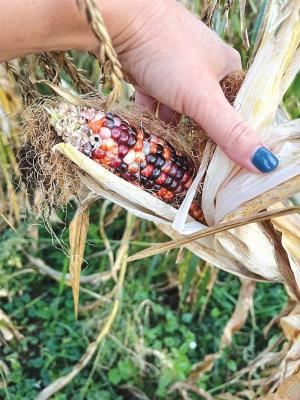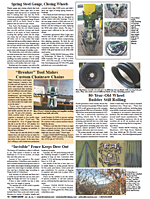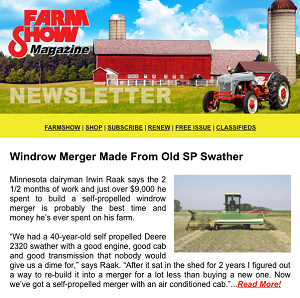She’s Milling Corn Mexican Style
 ✖  |
Alondra Cano wants to adapt Mexican corn varieties to the Midwest to recreate the fresh masa that is her cultural heritage. Masa is a dough or flour made from corn that has been softened by soaking in alkali (a process called nixtamalization) and then finely ground. It’s used to make tortillas, tamales and other Latin American foods. As a first step, she’s working with existing heirloom corn varieties already found in the U.S.
“We’re growing five different varieties and testing them for flavor, hardiness and susceptibility to disease,” says Cano. “We’re also looking at the nutritional profile to compare it with the masa harina (masa flour) available in Latin markets and food sections of supermarkets. Most of it comes from conventional field corn raised in the Midwest.”
As a farmer education specialist with Marbleseed, formerly MOSES, Cano works with regenerative and organic farmers in the Midwest. However, her Mexican-style corn variety research is based at Hungry Turtle Farm near Amery, Wis.
This past season was Cano’s first year planting corn seed provided by various heirloom seed savers/producers. “We waited a month after sweet corn and field corn had been planted in the area to prevent cross-pollination,” says Cano. “The heirloom corn was easy to maintain. By early fall, it looked good, and we harvested some, prepared it and had a dinner based on it. We were excited to taste it.”
Nixtamalizing the corn to make masa is critical. Typically, a small amount of calcium hydroxide is added to the corn and water. This is brought to a boil, let sit, drained and rinsed. At this point, the corn is called nixtamal and is ready to be ground, either wet as it is or dried first and then ground and used like conventional cornmeal.
“In Latin cultures, it’s more likely to be used as wet corn, boiled with other ingredients and then ground,” says Cano. “The colors at that point vary according to the dry kernels’ appearance. They can be white or yellow, blue or purple and even red, pink or brown.”
Once Cano identifies preferred varieties, she plans to introduce them and promote the nixtamal process to the marketplace. At the same time, she’ll need to work with farmers to grow the heirloom corn and achieve a scale or volume significant enough to compete with commercial products. The challenge is to build a market and match it to production at the same time.
“We’ve been contacting restaurants and identifying those who will sign a contract with us and establish how much they’ll need,” says Cano. “We’re working with many farmers locally and, at the same time, looking at how we can import seed from Mexico to adapt to the Midwest.”
Cano is confident that her corn will be welcomed by consumers and restauranteurs alike. The early fall dinner was proof for her.
“There isn’t a sugary pop,” says Cano. “The intensity of the product is so beautiful. When you eat it, you feel full, with a grounded, earthy feeling.”
Contact: FARM SHOW Followup, Alondra Cano, Marbleseed, P.O. Box 339, Spring Valley, Wis. 54767 (ph 612-483-5359; alondra.cano@marbleseed.org; https://marbleseed.org).

Click here to download page story appeared in.
Click here to read entire issue
She’s Milling Corn Mexican Style CROPS New Techniques Alondra Cano wants to adapt Mexican corn varieties to the Midwest to recreate the fresh masa that is her cultural heritage Masa is a dough or flour made from corn that has been softened by soaking in alkali a process called nixtamalization and then finely ground It’s used to make tortillas tamales and other Latin American foods As a first step she’s working with existing heirloom corn varieties already found in the U S “We’re growing five different varieties and testing them for flavor hardiness and susceptibility to disease ” says Cano “We’re also looking at the nutritional profile to compare it with the masa harina masa flour available in Latin markets and food sections of supermarkets Most of it comes from conventional field corn raised in the Midwest ” As a farmer education specialist with Marbleseed formerly MOSES Cano works with regenerative and organic farmers in the Midwest However her Mexican-style corn variety research is based at Hungry Turtle Farm near Amery Wis This past season was Cano’s first year planting corn seed provided by various heirloom seed savers/producers “We waited a month after sweet corn and field corn had been planted in the area to prevent cross-pollination ” says Cano “The heirloom corn was easy to maintain By early fall it looked good and we harvested some prepared it and had a dinner based on it We were excited to taste it ” Nixtamalizing the corn to make masa is critical Typically a small amount of calcium hydroxide is added to the corn and water This is brought to a boil let sit drained and rinsed At this point the corn is called nixtamal and is ready to be ground either wet as it is or dried first and then ground and used like conventional cornmeal “In Latin cultures it’s more likely to be used as wet corn boiled with other ingredients and then ground ” says Cano “The colors at that point vary according to the dry kernels’ appearance They can be white or yellow blue or purple and even red pink or brown ” Once Cano identifies preferred varieties she plans to introduce them and promote the nixtamal process to the marketplace At the same time she’ll need to work with farmers to grow the heirloom corn and achieve a scale or volume significant enough to compete with commercial products The challenge is to build a market and match it to production at the same time “We’ve been contacting restaurants and identifying those who will sign a contract with us and establish how much they’ll need ” says Cano “We’re working with many farmers locally and at the same time looking at how we can import seed from Mexico to adapt to the Midwest ” Cano is confident that her corn will be welcomed by consumers and restauranteurs alike The early fall dinner was proof for her “There isn’t a sugary pop ” says Cano “The intensity of the product is so beautiful When you eat it you feel full with a grounded earthy feeling ” Contact: FARM SHOW Followup Alondra Cano Marbleseed P O Box 339 Spring Valley Wis 54767 ph 612-483-5359; alondra cano@marbleseed org; https://marbleseed org
To read the rest of this story, download this issue below or click
here to register with your account number.







